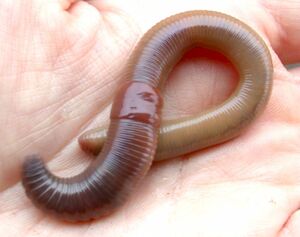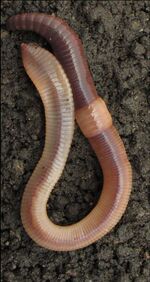Lumbricus terrestris

| |
| Kingdom: | Animalia |
|---|---|
| Phylum: | Annelida |
| Class: | Clitellata |
| Order: | Opisthopora |
| Family: | Lumbricidae |
| Genus: | Lumbricus |
| Species: | L. terrestris |
| Source: Integrated Taxonomic Information System[1] | |
Lumbricus terrestris is a species of earthworm which has been distributed across a majority of the globe due to farming practices and commercial industries[2] Due to its wide distribution, the worm has a variety of common names, including nightcrawler, Canadian nightcrawler, and dewworm[1]. As an earthworm, its habits are critical to observe because of its effect on the soil structure around it. L. terrestris is thought to have originated from Europe, because its introduction occurs with European settlement; there has been some suggestions that the nightcrawler came first with the landing of the Mayflower in North America[3]. The environmental effect of this earthworm as an exotic species in North American temperate forests especially has only just started to be more intensely studied in the last three decades[2].
Description

Like all earthworms, L. terrestris is a soft-bodied, cylindrical, segmented animal[4]. The nightcrawler is a relatively larger earthworm: length averages between 110-200 mm, with a diameter of 7-10 mm. They're usually a dark brown color, with a reddish hue which fades towards the end, which is slightly flattened; the coloration pattern is referred to as being dorsally pigmented[5]. The puffy looking 'pad' in the middle of the worm is known as the clitellum; this is the source of secretion of mucous used during mating between L. terrestris individuals, as well as where the cocoon containing one or more embryos is secreted from[4].
L. terrestris also has setae, small and stiff hair-like bristles which are used to help anchor and control the worm's movement through the soil. On L. terrestris the setae is closely paired, with some variation across the body.[5]
Ecology
L. terrestris is an anecic earthworm, one which creates deep burrows far down into the soil[4]. Earthworms in general are engineers of the surrounding environment in soil due to their close relationship with soil, and anecic earthworms are very impactful of the soil environment because of their characteristic deep burrows, which tend to be permanent[4]. The burrows not only bring leaf litter down further into the soil profile, but also the earthworms deposit middens above ground, creating small areas where there are increased nutrients and soil from further below in the soil profile.[4]
The soil mixing which anecic earthworms perform means that the soil horizons in which they live and interact with are known as "mull" soil horizons, which is when organic matter is extremely well mixed into the upper mineral soil. This has an extreme end to the spectrum, where the horizon is extremely granular, and characterized by organic mineral complexes which consist of earthworm casts; this is known as "vermimull"[4] This is extremely common in areas where L. terrestris is abundant and an exotic species, such as Western New York. If you see small granular piles on the ground outside, this is the result of many earthworms in the area.
Diet
L. terrestris tends to eat the surface litter on the soil in which they live, as well as whatever they happen to eat while moving through the soil which, of course, includes the soil itself[6].
Reproduction
The nightcrawler is a hermaphroditic species, reproducing as most members of the Opisthopora order do. The key mechanism to remember where it concerns earthworm reproduction is simply: mucus. The earthworms arrange themselves in opposite directions, lining up their spermataphores with the other worm's spermathecal pore where the sperm will be stored in a sperm sack until it is released in a cocoon along with fertilized eggs likely to be deposited near the soil surface[7].

Effect as an Invasive Species
Despite being introduced over 100 years ago, L. terrestris still is not a native earthworm to the northern portion of the United States. The well-supported theory is that native earthworm species are effectively non-existent in the northern forests of North America because the last glacial period prevented earthworms from living in the area through its duration; in addition, due to the small size of earthworms, it is difficult for them to swiftly colonize on their own[8]. The effect of an anecic earthworm in particular, which eats litter layer, has serious impacts on Northern temperate deciduous forests. The annual loss of leaves and decomposition of these leaves on the forest floor is what leads to nutrient cycling on the forest floor and creates fertile soil in these forests. The addition of L. terrestris in great numbers can reduce this leaf litter and so disrupt nutrient cycling and encourage nutrient loss in these areas which have no history of earthworm activity[8]. This disruption of nutrient cycling and mixing of soil horizons may also affect processes which occur within the rhizosphere, and other microfauna which interacts with plant roots belowground.
References
- ↑ 1.0 1.1 "Integrated Taxonomic Information System - Report", ITIS USGS Open-File Report 2006-1195: Nomenclature", USGS, n.d.. Retrieved 5/1/2022.
- ↑ 2.0 2.1 Patrick J Bohlen, Stefan Scheu, Cindy M Hale, Mary Ann McLean, Sonja Migge, Peter M Groffman, and Dennis Parkinson, "Non-native invasive earthworms as agents of change in northern temperate forests", Front Ecol Environ 2004; 2(8): 427–435, 2004. Retrieved 5/1/2022.
- ↑ Nicholas Henshue, "Earthworm Diversity", Soil Ecology: University at Buffalo, 4/6/2022. Retrieved 5/1/2022.
- ↑ 4.0 4.1 4.2 4.3 4.4 4.5 Coleman, D. C., and D. A. Crossley, "Fundamentals of Soil Ecology. Third edition.", Elsevier/Academic Press, London ; San Diego, CA., 2018. Retrieved 3/29/2022.
- ↑ 5.0 5.1 S James, "Data Sheet: Lumbricus Terrestris", CABI, Invasive Species Compendium, 22/12/10. Retrieved 5/1/2022.
- ↑ A. Milcu, J. Schumacher, S. Scheu, "Earthworms (Lumbricus terrestris) affect plant seedling recruitment and microhabitat heterogeneity", Functional Ecology , Apr., 2006, Vol. 20, No. 2 (Apr., 2006), pp. 261-268. April 2006. Retrieved 5/1/2022.
- ↑ Jefferey, "Earthworm Reproduction – How Do Worms Reproduce?", TheWormPeople. 24 April 2021. Retrieved 5/2/2022.
- ↑ 8.0 8.1 Patrick J. Bohlen, Peter M. Groffman, Timothy J. Fahey, Melany C. Fisk, Esteban Suarez, Derek M. Pelletier, and Robert T. Fahey, "Ecosystem Consequences of Exotic Earthworm Invasion of North Temperate Forests", Ecosystems (2004) 7: 1–12, 12 January 2004. Retrieved 5/2/2022